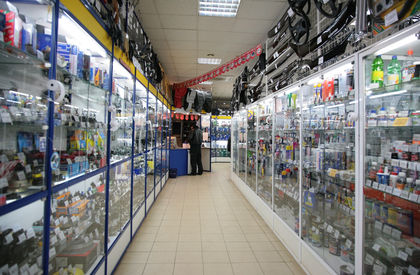JOB SHOP

A job shop is a type of manufacturing process structure where small batches of a variety of custom products are made. In the job shop process flow, most of the products produced require a unique set-up and sequencing of processing steps. Examples of a job shop include a machine tool shop, a factory machining center, paint shops, a French restaurant, a commercial printing shop, and other manufacturers that make custom products in small lot sizes. Volume and standardization is low and products are often one of a kind.
CHARACTERISTICS OF A JOB SHOP
LAYOUT In the job shop, similar equipment or functions are grouped together, such as all drill presses in one area and grinding machines in another in a process layout. The layout is designed to minimize material handling, cost, and work in process inventories. Job shops use general purpose equipment rather than specialty, dedicated product-specific equipment. Digital numerically controlled equipment is often used to give job shops the flexibility to change set-ups on the various machines very quickly. Job shops compete on quality, speed of product delivery, customization, and new product introduction, but are unlikely to compete on price as few scale economies exist.
ROUTING When an order arrives in the job shop, the part being worked on travels throughout the various areas according to a sequence of operations. Not all jobs will use every machine in the plant. Jobs often travel in a jumbled routing and may return to the same machine for processing several times. This type of layout is also seen in services like department stores or hospitals, where areas are dedicated to one particular product (men's clothing) or one type of service (maternity ward).
EMPLOYEES Employees in a job shop are typically highly skilled craft employees who can operate several different classes of machinery. These workers are paid higher wages for their skill levels. Due to their high skill level, job shop employees need less supervision. Workers may be paid a standard hourly wage or by an incentive system. The role of management is to bid on jobs and to establish prices for customer orders. The key activity in a job shop is processing information.
INFORMATION Information is the most critical aspect of a job shop. Information is needed to quote a price, bid on a job, route an order through the shop, and specify the exact work to be done. Information begins with quoting, then a job sheet and blueprint are prepared before the job is released to the floor. Once on the production floor, employees complete job sheets and time cards for labor cost calculations and to update records for quoting future jobs when variances are present.
While it is often easy to bid on jobs the shop has manufactured before, new jobs require accurate costing of labor, materials, and equipment as well as accurate assigning of overhead to the job. Tickets follow each job through the shop, where time and activities are recorded. Because the job shop makes specialty, custom items, it competes on quality and customer service and not on price. The job shop has little if any raw materials inventory because customers bring in the parts and materials to be worked on. The job shop has work-in-process inventory while jobs are being completed, but typically the customer is waiting on the order and expects prompt delivery, so there is no finished goods inventory in this make-to-order environment. Some job shops, like many small businesses, thrive on managing cash flow. They may work on small jobs to complete them by the end of the month so they can bill customers for the work.
SCHEDULING A job is characterized by its route, its processing requirements, and its priority. In a job shop the mix of products is a key issue in deciding how and when to schedule jobs. Jobs may not be completed based on their arrival pattern in order to minimize costly machine set-ups and change-overs. Work may also be scheduled based on the shortest processing time.
Capacity is difficult to measure in the job shop and depends on lot sizes, the complexity of jobs, the mix of jobs already scheduled, the ability to schedule work well, the number of machines and their condition, the quantity and quality of labor input, and any process improvements.
JOB SHOPS AS AN EARLY FORM OF MANUFACTURING ORGANIZATION
Most manufacturers today began as job shops and grew into the other manufacturing processes as volume allowed. The job shop allows entrepreneurs the most flexibility in making a variety of products to meet customer quality and service standards. As customers request repeat jobs and as volumes grow, the job shop may group machines into work cells to process batches of like jobs.
Job shops are one of the first structures for a manufacturer in the process life cycle. As volume increases and manufacturers reduce or standardize their product offerings, structures change from the job shop to a batch flow to an assembly line and then to a continuous flow. Over the life cycle, flexibility decreases due to high volume and standardization, but unit costs decrease. The job shop is organized by process, where assembly lines or continuous flow operations are organized in a product layout. In the latter layout, equipment or work processes are arranged according to the exact steps in which the product is made and the path for each part resembles a straight line.
FURTHER READING:
Chass, R.B., N.J. Aquilamo, and F.R. Jacobs. Operations Management for Competitive Advantage. 9th ed. Burr Ridge, IL: McGraw-Hill Irwin, 2001.
Schmenner, Roger W. Plant and Service Tours in Operations Management . Saddle River, NJ: Prentice Hall, 1998.
Comment about this article, ask questions, or add new information about this topic: